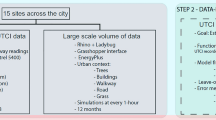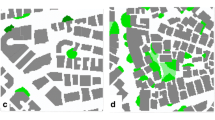Abstract
A comfortable outdoor thermal environment is very important for pedestrian’s health and safety. Many specific design scenarios were well documented in previous studies. However, simulation studies about microclimate for one month/season are still lacking. In this paper, an hourly simulation system for outdoor thermal environment was developed to study more about the impact of time dependent parameters on outdoor microclimate. To evaluate pedestrians’ thermal comfort condition, thermal indexes for hourly evaluation were proposed. A comfortable outdoor environment was defined as an environment in which pedestrians can reach comfort by adjusting their clothes insulation. A simple case of a 100 m × 100 m block with six 16-floor buildings was studied and results of different time durations were analyzed. From simulation results of each season, it can be concluded that both the radiation and ventilation conditions are the main aspects of outdoor thermal environment design. Simulation results of two typical summer hours and the “average temperature day” differ from that of one month. If only one hour or one day is considered, the designers will be misled by the simulation. In this case, simulation system for hourly evaluation is more informative. Results of statistical sampling method were compared with hourly simulation. The comparison shows that designers can reduce the calculation time by only simulating the sampled hours at the preliminary design stage.
Similar content being viewed by others
References
Ali-Toudert F, Mayer H (2006). Numerical study on the effects of aspect ratio and orientation of an urban street canyon on outdoor thermal comfort in hot and dry climate. Building and Environment, 41: 94–108.
Ali-Toudert F, Mayer H (2007). Effects of asymmetry, galleries, overhanging facades and vegetation on thermal comfort in urban street canyons. Solar Energy, 81: 742–754.
ASHRAE (2011). ASHRAE Fundamentals Handbook (SI-Edition). Atlanta: American Society of Heating, Refrigerating and Air-Conditioning Engineers.
Blocken B, Carmeliet J (2004). Pedestrian wind environment around buildings: Literature review and practical examples. Journal of Building Physics, 28: 107–159.
Chen H, Ooka R, Kato S (2008). Study on optimum design method for pleasant outdoor thermal environment using genetic algorithms (GA) and coupled simulation of convection, radiation and conduction. Building and Environment, 43: 18–30.
Chen H, Ooka R, Huang H, Tsuchiya T (2009). Study on mitigation measures for outdoor thermal environment on present urban blocks in Tokyo using coupled simulation. Building and Environment, 44: 2290–2299.
De Carli M, Olesen BW, Zarrella A, Zecchin R (2007). People’s clothing behaviour according to external weather and indoor environment. Building and Environment, 42: 3965–3973.
Durbin P (1996). On the k-ɛ stagnation point anomaly. International Journal of Heat and Fluid Flow, 17: 89–90.
Emmanuel R, Rosenlund H, Johansson E (2007). Urban shading—A design option for the tropics? A study in Colombo, Sri Lanka. International Journal of Climatology, 27: 1995–2004.
Gagge AP, Fobelets AP, Berglund LG (1986). A standard predictive index of human response to the thermal environment. ASHRAE Transactions, 92(2B): 709–731.
Gaitani N, Mihalakakou G, Santamouris M (2007). On the use of bioclimatic architecture principles in order to improve thermal comfort conditions in outdoor spaces. Building and Environment, 42: 317–324.
Gebhart B (1959). A new method for calculation radiant exchange. ASHRAE Transactions, 65: 321–332.
Givoni B, Noguchi M, Saaroni H, Pochter O, Yaacov Y, Feller N, Becker S (2003). Outdoor comfort research issues. Energy and Buildings, 35: 77–86.
Höppe P (1993). Heat balance modelling. Cellular and Molecular Life Sciences, 49: 741–746.
Hwang R-L, Lin T-P, Cheng M-J, Lo J-H (2010). Adaptive comfort model for tree-shaded outdoors in Taiwan. Building and Environment, 45: 1873–1879.
Hwang R-L, Lin T-P, Matzarakis A (2011). Seasonal effects of urban street shading on long-term outdoor thermal comfort. Building and Environment, 46: 863–870.
Jendritzky G, Bucher K, Laschewski G, Walther H (2000). Atmospheric heat exchange of the human being, bioclimate assessments, mortality and thermal stress. International Journal of Circumpolar Health, 59: 222–227.
Kusuda T (1969). Thermal response factors for multi-layer structures of various heat conduction system. ASHRAE Transactions, 75(1): 241–271.
Li Q, Meng Q, Zhao L, Xuan Y, Mochida A, Yoshino H (2010). Correlation analysis of urban planning factors and outdoor thermal environment around the residential buildings in hot-humid area of China. In: Proceedings of International Conference on Advances in Energy Engineering (ICAEE2010), Beijing, China, pp. 388–391.
Lin B, Li X, Zhu Y, Qin Y (2008). Numerical simulation studies of the different vegetation patterns’ effects on outdoor pedestrian thermal comfort. Journal of Wind Engineering and Industrial Aerodynamics, 96: 1707–1718.
Ma J, Li X, Zhu Y (2012). A simplified method to predict the outdoor thermal environment in residential district. Building Simulation, 5: 157–167.
Matzarakis A (2001). Assessing climate for tourism purposes: Existing methods and tools for the thermal complex. In: Proceedings of 1st International Workshop on Climate, Tourism and Recreation, Porto Carras, Greece, pp. 101–112.
Murakami S, Otsuka K, Mochida A, Kataoka H, Kato S (2003). CFD prediction of flow over complex terrain using Local Area Wind Energy Prediction System (LAWEPS). In: Proceedings of 11th International Conference on Wind Engineering, Texas, USA, pp. 2821–2828.
Nakamura Y (1987). Expression method of the radiant field on a human body in buildings and urban spaces. Journal of Architecture, Planning and Environmental Engineering, 376: 29–35. (in Japanese)
Ng E, Chen L, Wang Y, Yuan C (2012). A study on the cooling effects of greening in a high-density city: An experience from Hong Kong. Building and Environment, 47: 256–271.
Oguro M, Morikawa Y, Murakami S, Matsunawa K, Mochida A, Hayashi H (2008). Development of a wind environment database in Tokyo for a comprehensive assessment system for heat island relaxation measures. Journal of Wind Engineering and Industrial Aerodynamics, 96: 1591–1602.
Omori T, Murakami S, Kato S (1997). Numerical simulation of solar heat absorption within indoor space by means of composite grid method. ASHRAE Transactions, 103(1): 164–171.
Ooka R, Chen H, Kato S (2008). Study on optimum arrangement of trees for design of pleasant outdoor environment using multi-objective genetic algorithm and coupled simulation of convection, radiation and conduction. Journal of Wind Engineering and Industrial Aerodynamics, 96: 1733–1748.
Pearlmutter D, Berliner P, Shaviv E (2007). Integrated modeling of pedestrian energy exchange and thermal comfort in urban street canyons. Building and Environment, 42: 2396–2409.
PickupJ, de Dear R (1996). An outdoor thermal comfort index (OUTSET*)—Part 1: The model and its assumptions. In: Proceedings of 15th International Congress Biometeorology and International Conference on Urban Climatology, Sydney, Australia, pp.279–283.
Priyadarsini R, Hien WN, Wai David CK (2008). Microclimatic modeling of the urban thermal environment of Singapore to mitigate urban heat island. Solar Energy, 82: 727–745.
Robitu M, Musy M, Inard C, Groleau D (2006). Modeling the influence of vegetation and water pond on urban microclimate. Solar Energy, 80: 435–447.
Santamouris M, Gaitani N, Spanou A, Saliari M, Giannopoulou K, Vasilakopoulou K, Kardomateas T (2012). Using cool paving materials to improve microclimate of urban areas—Design realization and results of the flisvos project. Building and Environment, 53: 128–136.
Sasaki K, Mayer H, Mochida A, Uchida M, Tonouchi T (2009). Field measurement on thermal comfort in outdoor locations—Comparison of SET* and PET based on questionnaire survey. In: Proceedings of 7th International Conference on Urban Climate, Yokohama, Japan.
Shimazaki Y, Yoshida A, Suzuki R, Kawabata T, Imai D, Kinoshita S (2011). Application of human thermal load into unsteady condition for improvement of outdoor thermal comfort. Building and Environment, 46: 1716–1724.
Spagnolo J, de Dear R (2003). A field study of thermal comfort in outdoor and semi-outdoor environments in subtropical Sydney Australia. Building and Environment, 38: 721–738.
Stephenson DG, Mitalas GP (1967). Room thermal response factors. ASHRAE Transactions, 73(1): III.2.1–III.2.10.
Tominaga Y, Mochida A, Yoshie R, Kataoka H, Nozu T, Yoshikawa M, Shirasawa T (2008). AIJ guidelines for practical applications of CFD to pedestrian wind environment around buildings. Journal of Wind Engineering and Industrial Aerodynamics, 96: 1749–1761.
Tseliou A, Tsiros I, Lykoudis S, Nikolopoulou M (2010). An evaluation of three biometeorological indices for human thermal comfort in urban outdoor areas under real climatic conditions. Building and Environment, 45: 1346–1352.
Wong N, Jusuf S (2008). GIS-based greenery evaluation on campus master plan. Landscape and Urban Planning, 84: 166–182.
Xi T, Li Q, Mochida A, Meng Q (2012). Study on the outdoor thermal environment and thermal comfort around campus clusters in subtropical urban areas. Building and Environment, 52: 162–170.
Zhai Y, Jin L, Meng Q, Zhang Y, Zhao L (2009). A field study of thermal comfort in outdoor environment in Guangzhou, China. In: Proceedings of 6th International Symposium on Heating, Ventilating and Air Conditioning (IHVAC2009), Nanjing, China, pp. 795–802.
Author information
Authors and Affiliations
Corresponding author
Rights and permissions
About this article
Cite this article
Ma, J., Li, X. & Zhu, Y. An hourly simulation method for outdoor thermal environment evaluation. Build. Simul. 8, 113–122 (2015). https://doi.org/10.1007/s12273-014-0206-3
Received:
Revised:
Accepted:
Published:
Issue Date:
DOI: https://doi.org/10.1007/s12273-014-0206-3




